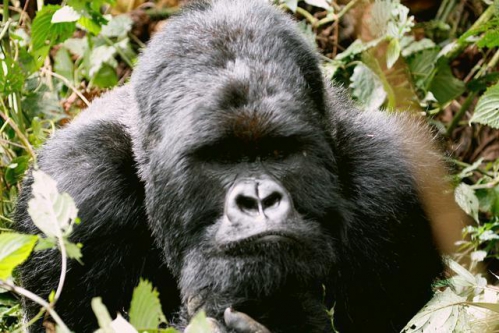Rwanda offers magical encounter with endangered gorillas
22/08/2014
Pamela Roth, Edmonton Sun
It’s hard to find the words to describe the sensation of looking into the eyes of a wild mountain gorilla standing so close you could touch it.
Thrilling, mesmerizing, magical, awesome are just a few of the sensations rippling through me as I lock eyes with a female gorilla casually munching on a plant. It feels as though we’re long lost friends. My heart fills with joy. I can’t believe I am here.
I had just hiked two hours up the slopes of Mount Bisoke in Rwanda’s Volcanoes National Park with eight people, including my father. When I’m told to put on my rain jacket and garden gloves for protection against the stinging nettle bushes we’re about to walk through, nothing could have prepared me for what I would experience on the other side.
On the ground, reclining on its side, a male silverback gorilla is having a mid-morning nap. Two smaller gorillas do the same behind him. One of them perks up and takes note of the people staring at him in disbelief. A female gorilla and her baby sleep a few feet away. Another silverback — the leader of the group — lurks in the bushes nearby.
I feel as if I’ve been transported into another world. “Holy mackerel!” says my wide-eyed father as he soaks in the magical scene around him.
On a 16-day tour with Intrepid Travel, we have come to Rwanda in Central-Eastern Africa to experience the thrill of seeing the world’s largest living primates in their natural habitat.
Less than 900 mountain gorillas are now left in the wild. They roam the forests of an extinct volcanic region along the borders of Rwanda, Uganda and the Democratic Republic of the Congo, and remain an endangered species.
Each day, groups of eight people are guided to spend an hour with one of the 10 habituated families used for ecotourism in Volcanoes National Park. (Habituated means they are used to short visits by humans.) The other eight families are studied for research purposes.
To find the gorillas, a team of trackers are out at 6 a.m. looking for the families, then radio their whereabouts to the guides. On this particular day, we’re tracking the Ntambaru Group, which has 14 members lead by one male silverback.
FULL ARTICLE : HERE
A découvrir aussi
- Natural Beauty in East Africa : Volcanoes National Park in Rwanda
- Gorillas in the Mist : 25 Things You Didn't Know about the film
- The night life in the Akagera National Park

